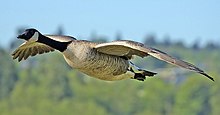Goose
From Wikipedia, the free encyclopedia
"Geese" redirects here. For the SNK character, see Geese Howard.
For other uses, see Goose (disambiguation).
| Goose | |
|---|---|
 | |
| Canada Goose, Branta canadensis | |
| Scientific classification | |
| Kingdom: | Animalia |
| Phylum: | Chordata |
| Class: | Aves |
| Superorder: | Galloanserae |
| Order: | Anseriformes |
| Family: | Anatidae |
| Subfamily: | Anserinae |
| Tribe: | Anserini |
| Genera | |
| Anser Branta and see text | |
This article deals with the true geese in the subfamily Anserinae, tribe Anserini.
A number of other waterbirds, mostly related to the shelducks, have "goose" as part of their name.
Contents[hide] |
[edit] Etymology

Canada Goose (Branta canadensis) gosling
The term goose applies to the female in particular. The word gander is used for a male in particular. Young birds before fledging are called goslings. A group of geese on the ground is called a gaggle; when geese fly in formation they are called a wedge or a skein (see also list of collective nouns for birds).
[edit] True geese

Canada Geese near Lake Erie

Geese on Lake Lawtonka.
Either these or, more probably, the goose-like Coscoroba Swan is the closest living relative of the true geese.
Fossils of true geese are hard to assign to genus; all that can be said is that their fossil record, particularly in North America, is dense and comprehensively documents many different species of true geese that have been around since about 10 million years ago in the Miocene. The aptly named Anser atavus (meaning "Great-great-great-grandfather goose") from some 12 million years ago had even more plesiomorphies in common with swans. In addition, there are some goose-like birds known from subfossil remains found on the Hawaiian Islands.
Geese are monogamous, living in permanent pairs throughout the year; however, unlike most other permanently monogamous animals, they are territorial only during the short nesting season. Paired geese are more dominant and feed more, two factors that result in more young.[1]
[edit] Other birds called "geese"
There are a number of mainly southern hemisphere birds called "geese", most of which belong to the shelduck subfamily Tadorninae. These are:- Orinoco Goose, Neochen jubata
- Egyptian Goose, Alopochen aegyptiacus
- The South American sheldgeese, genus Chloephaga
- The prehistoric Madagascar Sheldgoose, Centrornis majori, the "Woodard"
The Spur-winged Goose, Plectropterus gambensis, is most closely related to the shelducks, but distinct enough to warrant its own subfamily, the Plectropterinae.
The three species of small waterfowl in the genus Nettapus are named "pygmy geese", e.g. the Cotton Pygmy Goose (N. javanica). They seem to represent an ancient lineage like the Cape Barren Goose and the Spur-winged Goose.
A genus of prehistorically extinct seaducks, Chendytes, is sometimes called "diving-geese" due to their large size.
The unusual Magpie Goose is in a family of its own, the Anseranatidae.
The Northern Gannet, a seabird, is also known as the "Solan Goose" although it is a bird unrelated to the true geese, or any other Anseriformes for that matter.




No comments:
Post a Comment